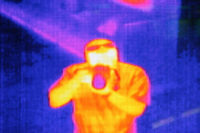New Video Cameras Catch the Details of Fast-Paced Action

The eye in the sky can now see better than ever. New Internet protocol (IP)-based megapixel cameras are becoming more common in the casino environment, bringing with them advantages such as clearer images, better resolution and the ability to cover larger areas with fewer cameras. Surveillance systems that incorporate megapixel or high-definition (HD) cameras are better equipped to monitor fast-paced gaming action and better able to differentiate the suits of a playing card, the numbers on a die, or the quick moves of a cheater looking for an advantage over the casino.
Native American casinos are leading the transition to IP-based video in the gaming arena, with many casinos in Las Vegas and Atlantic City still using analog systems. The recession has likely slowed the transition to networked systems as hard-hit casinos delay system upgrades and investments until better economic times. However, the newer IP camera systems are worth the investment. They offer performance that is far superior to analog video, restricted as it is to a specific resolution that was the industry standard for almost 70 years. Newer IP-based systems enable use of megapixel cameras to provide images with a million or more pixels, which equates to much more detailed resolution compared to standard network or analog cameras.
Clear images are especially valuable in the casino community, where they can enable operators to identify faces and distinguish among card suits or the values of chips. A cheater’s sleight-of-hand can happen in the blink of an eye, so every frame of video is critical, whether the target is suspected of card counting in blackjack or post-betting at the roulette table. Identifying cheaters as quickly as possible saves the casino more money, and resolving disputes with players efficiently enables game play to continue, which keeps everyone happy. Surveillance operators in the casino environment depend on pan-tilt-zoom (PTZ) functionality to enable them to direct their attention to specific incidents or to suspicious players, and new megapixel cameras that incorporate PTZ capability combine it with superior, higher-resolution images.
The terms megapixel and HD both describe cameras and video systems that provide more detailed resolution in the form of additional pixels. IP-based megapixel cameras connect to a networked system using Internet protocol, and video travels along the network like any other data. Additional network bandwidth and data storage are required to handle networked video, especially megapixel images.
IP-based networked cameras are now available in a variety of megapixel resolutions from 1.3 to 10 or more megapixels. Most of the growth in megapixel cameras will probably be in the lower-megapixel range (1.3 to 3 megapixels). The casino environment requires full-motion recording at 30 frames per second (30 fps) with no-loss recording even in the variable light conditions of the casino floors. Higher quality images are a core advantage of IP-based systems over analog systems, so the industry’s transition to IP-based systems will boost interest in megapixel technologies.
In contrast, HD video refers to one of two specific resolutions, both of which are greater than the previous “standard” for network cameras (which approximated analog). HD video is either 720p or 1080p, numbers which refer to the pixels of vertical resolution (compared to 480p for standard resolution).
HD sensors, like those used in 1.3-megapixel cameras, provide higher resolution images that feed more data overall to a networked video system. However, resolution is only one factor in image quality. Increasingly, intelligence inside each camera works together with HD image sensors to provide images that are better in multiple ways. For example, image processing manages the “dynamic range” of a video image, which is the span of gradations from the lightest to the darkest areas. Intelligence inside the camera uses natural contrast image correction to optimize contrast of each pixel and to faithfully reproduce objects in any area and position. The result is better images despite extreme lighting conditions. Another image processing technology can transform dark areas into natural, high-contrast images like those seen by the human eye. Adaptive digital noise reduction takes care of the “noise” in a camera image (extraneous elements that are not part of the picture), which is especially useful for moving objects.
Megapixel systems can also cost less, considering fewer cameras can often be used to cover larger areas with less network infrastructure. Another cost-saving camera feature is Power over Ethernet (PoE), which allows low-voltage electrical power to the camera to travel along network cabling, saving the cost of separate power supplies.
Away from the casino floor for other applications in the gaming/hospitality market, smarter and higher-resolution IP-based video cameras can also be integrated with IP-based systems such as retail point-of-sale (POS), human resources systems, retail loss prevention systems and even IP-based telephone systems with LCD displays that can be interfaced with video cameras for remote monitoring of a back office area, door access or cash handling.
Analog is still holding strong in a large sector of the gaming marketplace, but the transition to IP-based video is well under way. The results will be worth the wait, with the added benefit of higher-resolution cameras empowering video systems for the casino market that are better than ever.
Looking for a reprint of this article?
From high-res PDFs to custom plaques, order your copy today!







